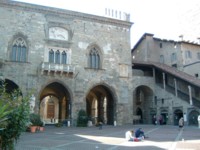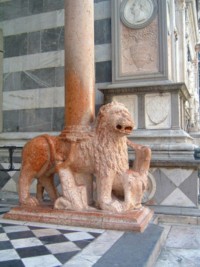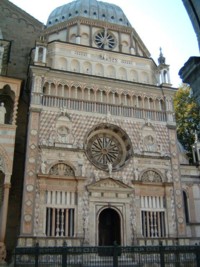Things to see in Bergamo

Bergamo (population 120,000) is an extremely pretty old town in Lombardy, on the edge of the Alps. Bergamo’s original location was a defensive hilltop, and the town was also protected by stout walls; nowadays this historic part of town is known as the Città Alta (upper town) and it’s where you will find most of the historic buildings and tourist sights. There is little traffic, and the narrow lanes are pleasant to wander.
Most of modern Bergamo spreads over the plain below the old town. This Città Bassa (lower town) was laid out around the beginning of the twentieth century, and is composed of pleasant wide boulevards. The two parts of town are linked by a funicular. Bergamo contains many sights of interest and architectural beauty, and there’s plenty to see on a weekend break as well as the possibilities of trips further afield, including explorations of the nearby mountains, the Bergamasque Alps. Bergamo is also a pleasant daytrip from Milan.
> Milan Bergamo airport, travel and general information
Find and book hotels. With location maps and guest reviews.
Città Alta (upper town)

Buses for the upper town leave from immediately outside the rail station, where buses to and from the airport also stop. They are yellow buses run by ATB and will have either Città Alta or Funicolare Superiore on the front. There are ticket machines (no change given) or you can buy tickets at a newspaper stand in the station.
There is a helpful tourist information office, which is is easily missed: it’s on the left only 100 metres/yards up Via Gombito from Piazza Mercato, where the funicular station brings its cargo of visitors.
At the heart of the old town is the lovely Piazza Vecchia (the main routes through the Città Alta all lead here). A wide open space surrounded by a mixture of medieval and Renaissance architecture, the piazza fills up with students from the university, chatting and picnicking around the fountain. There are several bars with tables on the square for a civilised spot of relaxation.
The most interesting of the palazzi facing onto Piazza Vecchia is the medieval Palazzo della Ragione. The portico dates back to the 12th century and connects Piazza Vecchia with the little Piazza del Duomo, home to an assortment of fine religious buildings – the Duomo, the church of Santa Maria Maggiore, the Colleoni Chapel and baptistery.
The church of Santa Maria Maggiore was begun in the 12th century. It’s a lovely building, and more interesting than the neighbouring Duomo (cathedral), with a soaring skyline. The interior of the church, with its octagonal dome, saw many modifications over the centuries, including the 16th century addition of rich Flemish tapestries. However, traces still remain of the original medieval frescoes, including parts of a ‘tree of life’ celebrating the life of Christ. One of the church’s most spectacular ornaments is a 1705 wooden confessional, carved by Andrea Fantoni, a hugely ornate extravagance which looks rather like expensive sculpted chocolate. The composer Donizetti’s tomb is in the back of the church.

Next door to Santa Maria Maggiore, and putting its simple facade into the shade, is the colourful Cappella Colleoni, or Colleoni Chapel. The renowned condottiere, or soldier of fortune Bartolomeo Colleoni hailed from Bergamo and commissioned the Colleoni chapel for his tomb. The chapel is a masterpiece of Lombard art, a fabulously ornate building completed in 1476. Colleoni himself is commemorated by a statue astride a gold charger, atop an elaborate two-tiered tomb.
A cheap joint ticket, organised by the Fondazione Bergamo nella Storia, covers an assortment of Bergamo’s tourist attractions – it’s good value and you don’t need to visit them all the same day. Attractions include the Rocca is a walled stronghold containing a local history museum, the Museo Storico (I once admired Garibaldi’s red-and-gold slippers in a Risorgimento display here). You can walk all around the ramparts and climb the tower for great views over the town and beyond. There are more good views from the the 12th-century tower Torre Civica in Piazza Vecchia (also known as the Campanone, or ‘big bell’). The tower (closed Mondays and lunchtimes) is included on the combined ticket. It has both stairs and a lift.
Other Bergamo museums include the Archaeological Museum (Museo Archeologico) and the Natural History & Science Museum (Museo Civico di Scienze Naturali) in Piazza Cittadella. They are both of international quality but the display information is in Italian only. It is also worth exploring the quiet cloister of the Convento di San Francesco: missed by most visitors, it has the remains of frescoes dating from the 15th to 18th centuries.
A photo-exhibition and a restored biplane which once commemorated the local aviator and explorer Antonio Locatelli are being housed, at the time of writing, in a woodwork museum in Almenno San Bartolomeo (the Museo del Falegname Tino Sana); worth a visit if you are travelling in that direction; though you should confirm the exhibition’s opening by email first.
Of interest to music fans, the Museo Donizettiano – Donizetti Museum – is located at Via Arena, 9. Born in Bergamo in 1797, Gaetano Donizetti is one of Bergamo’s most famous sons. The composer is buried in the church of Santa Maria Maggiore, and in the museum close by you can see musical instruments and artefacts from the professional and private life of Donizetti. Bergamo’s main theatre is dedicated to the composer, and every year a popular opera season is held celebrating Donizetti and his contemporaries.
Even higher than the Città Alta, and reachable by a second funicular, is San Vigilio, a small hilltop settlement which offers several pleasant and panoramic strolls. The transport company, ATB, provide an English-language leaflet about the funiculars which also lists several short walks around San Vigilio (with a map). The main attraction of San Vigilio is the Castello, a grassy ruined fortress with superb views to the mountains. To get to the Castello, turn right on leaving the funicular. There are several bars and restaurants for refreshments.
In the Città Alta there are some pleasant green spaces for a rest or a picnic. The park around the base of the Rocca is open to the public, has shady paths and benches and good views and the unusual addition of vintage artillery and even a tank. Bergamo also has a Botanical Garden, which is open from March to October and is free to enter. The garden is home to over 900 species, and is involved in conservation and research.
There are plenty of places to eat and drink in both the upper and the lower town. On my first trip several years ago, I ate at Da Franco, in the old town at Via Colleoni, 8; an excellent restaurant busy with both tourists and residents. Prices were reasonable and dishes include local specialities with many varieties of pasta and pizzas (including gorgonzola and apple pizza). More tips for refreshments: a popular-with-locals take-away pizza place in the Via Colleoni, and the bar-caffetteria Campanella at the quieter end of town in elegant Piazza Mascheroni (a good spot for a morning cappuccino) – there are also one or two smart trattorie there, away from the bustle.
Città Bassa (lower town)
Halfway along the straight, almost ceremonial, route from the station to the Citta Alta is the showpiece of modern Bergamo, the Porta Nuova district with its interconnected squares, promenades and civic architecture. Among them are the Donizetti Theatre and the rather dignified Law and Justice building opened by the then king in the 1920s. Even more interesting, though, is the Palazzo delle Poste, ten minutes walk up the Viale Antonio Locatelli – a striking art-deco demonstration of 1932 modernity. Along with carved fasces – the bundles of sticks copied from ancient Rome as a symbol of unity by Mussolini – there are four statues representing Etruscan, Roman, papal and fascist Italy. Only the last shows any dynamism, arm raised high in flat-handed fascist salute and front foot vigorously overlapping its podium.
The funicular is at the end of this mile-long route from the station. It costs a euro. If you are already fainting for refreshment, hold on until you reach the art nouveau cafe (with balcony and big view) at the upper terminus before going on into the old town.
The other district well worth visiting in the lower town is ten minutes walk left (west) of the Porta Nuova, among the arcaded surroundings of Largo Rezzana. Despite the feeble modern ‘fountain’ here, this is really an authentic part of the old town, inside the later Venetian walls – now long gone. There are several bars and restaurants for a leisurely break, and it’s also the starting point for by far the best way up to the Citta Alta on foot. Those who can summon the energy can follow in the steps of almost anyone coming to Bergamo during the course of many centuries. Take the Via Sant’ Alessandro and just keep going, bearing right eventually into Via S. Carlo. If, like us, you need refuelling before the way becomes too steep, the Bar Lo Spuntino (just before crossing Via Garibaldi) is the place for either a drink or a full meal. Early on, there are intriguing glimpses into private courtyards, and then the blank sides of two great churches. Later, the way dwindles to a cobbled path between high stone walls. There are trees, and in spring the call of cuckoos, before you arrive finally into the open, at the big Venetian gate to the upper town, with its hefty lion of Saint Mark.
One of Bergamo’s most important tourist attractions, located outside the town wall on Via della Nuca, is the town’s 200-year-old art gallery, the Accademia Carrara. The Accademia contains works by Botticelli, Bellini, Mantegna, Fra Angelico and many other masters. There are also special temporary exhibitions. [Note: at the time of writing the gallery is closed for restoration: some of the artworks are displayed at Palazzo della Ragione in the upper town. Check their website (see links panel) for the latest information].
Note that in typical Italian fashion, many of the sights close for up to three hours in the middle of the day. Take the opportunity to have a nice leisurely lunch.
On this site
External links